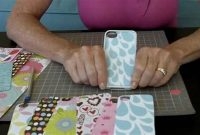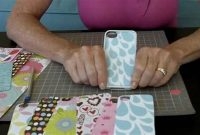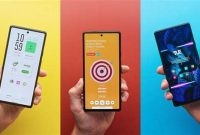If you’re looking for fresh ideas to redesign your phone, you’ll find a lot of inspiration in this article. From customizing your phone layout to choosing the right wallpaper, these tips will help you create a personalized phone that looks like it was designed by a professional. So, whether you want a minimalist look or a colorful interface, you can easily achieve it with these simple tips.

Understanding the Basics of Phone Design
Phone design is all about creating a product that’s user-friendly, visually appealing, and stands out from the competition. The elements that make up phone design are colors, shapes, sizes, and textures. All of these elements are important in creating a successful phone design, and understanding how to use them will help you develop a phone that will be both functional and aesthetically pleasing.
Color
Color is one of the most important elements in phone design. The color of a phone can help communicate the brand’s message, and also reflect the user’s personality. In phone design, there are two main approaches: using a range of colors or sticking to a single color. Companies like Apple often stick to a standard range of colors (black, white, and gray, for instance), while other companies offer a wider range of options. When choosing colors, it’s important to consider elements like the target demographic, user preferences, and the current market trends.
Shape
The shape of a phone is also an important factor in design. It’s common for phones to have a rectangular or oval shape, as this provides an ergonomic grip and allows for easy use. Many modern phone designs also utilize curved edges, as this creates a more sophisticated and modern look. However, it’s important to consider the practicalities of the phone’s shape—will it be easy to grip and use with one hand? Will it easily fit in a pocket?
Size
The size of a phone is a major consideration in the design process. While larger phones provide a bigger screen, they may be too bulky to carry around. On the other hand, smaller phones may be easier to handle, but they may have smaller screens that are harder to read. Phone manufacturers must consider what screen size will provide the best user experience while still being practical. In addition, the weight of the phone should also be considered, with heavier phones being more durable but also harder to carry around.
Texture
The texture of a phone refers to the finish applied to the body of the device. This can include features like a glossy or matte finish, as well as other details like ridges or smooth edges. The texture of a phone can provide a unique look and feel, and it can also impact how easy it is to handle. For instance, a phone with a textured finish may be easier to grip than one with a slick glossy finish. However, it’s important to balance aesthetics with functionality—a phone with a rough texture may be visually appealing, but may also be prone to scratching and damage over time.
Choosing the Right Phone Case
If you want to keep your phone safe and sound, getting a phone case is a no-brainer. However, selecting a phone case that not only protects your phone but also makes it look sleek can be quite challenging. This section will explore the different types of phone cases available and how they can protect your phone while also enhancing its appearance.
Types of Phone Cases
When it comes to phone cases, there are a variety of materials, styles, and designs to choose from. Here are some of the most common types of phone cases:
- Hard Shell Case: This type of phone case is made of plastic and is usually lightweight. It provides a basic level of protection from scratches and minor drops.
- Silicone Case: Made of soft, flexible silicone material, these cases are easy to grip and provide better protection against accidental drops than hard cases.
- Folio Case: This case features a cover that can provide full protection for the front and back of your device. It’s an excellent choice if you carry your phone in your pocket or purse often.
- Bumper Case: This type of case usually has a soft layer inside a hard shell to absorb shocks and prevent damage from falls. It’s ideal for those who want protection but don’t want to add bulk to their phone.
- Wallet Case: As the name suggests, a wallet case can double up as a phone case and a wallet. It has card slots and pockets to store important cards and cash along with your phone.
Choosing the Right Phone Case
When purchasing a phone case, consider a few factors, such as your lifestyle, how often you use your phone and what degree of protection you require.
If you have an active lifestyle or frequently use your phone outdoors, a rugged case that provides maximum protection from falls and dust might be the best option for you. On the other hand, if you rarely drop your phone and want it to look sleek and professional, a hard shell or folio case might suit your needs.
Customizing Your Phone Wallpaper
One of the easiest ways to personalize your phone is by changing its wallpaper. You can choose a pre-set wallpaper or use a custom image that reflects your style and preferences. Here are some tips to help you customize your phone’s wallpaper:
Selecting a Pre-Set Wallpaper
If you don’t want to use a custom image as your wallpaper, you can choose from a variety of pre-set wallpapers offered on your phone. Here’s how to do it:
- Go to ‘Settings’ on your phone.
- Find ‘Wallpaper’ or ‘Display and Wallpaper’ depending on your device.
- Select ‘Wallpaper’ and choose ‘My Photos’, ‘Gallery’, or ‘Wallpaper Gallery’ depending on the option provided to you by your device.
- Choose the pre-set wallpaper you like and select ‘Set as Wallpaper’.
Using a Custom Image as Wallpaper
If you want to use a custom image as your wallpaper, you can either use one of your own pictures or download one from the internet. Here’s how to use a custom image as your wallpaper:
- Go to ‘Settings’ on your phone.
- Find ‘Wallpaper’ or ‘Display and Wallpaper’ depending on your device.
- Select ‘Wallpaper’ and choose ‘My Photos’, ‘Gallery’, or ‘Wallpaper Gallery’ depending on the option provided to you by your device.
- Choose the image you want to use as your wallpaper and select ‘Set as Wallpaper’.
Creating a Customized Wallpaper
If you want to create a more personalized wallpaper, you can use image editing apps like Canva, Adobe Photoshop, or even the built-in editing features on your phone. Here are some tips to help you create your customized wallpaper:
- Choose an image that reflects your personality or interests.
- Use vibrant colors and bold graphics to make your wallpaper stand out.
- Add text or a quote to your image to make it more inspirational or motivational.
With these tips, you can easily customize your phone’s wallpaper to reflect your personal style and preferences. Whether you choose a pre-set wallpaper or a custom image, your phone will look more like your own.
Personalizing Your App Icons
If you’re tired of looking at the same generic app icons on your phone screen, it’s time to learn how to customize them. By personalizing your app icons, you can give your phone a unique and stylish look that reflects your personality. Here’s how:
Using Third-Party Apps
One of the easiest ways to personalize your app icons is by using third-party apps. There are several apps available both on the App Store and Google Play that allow you to customize your app icons with ease. These apps offer a wide range of pre-designed icons that you can choose from. You can also create custom icons by uploading your own images or choosing from the app’s library of designs. Once you’ve selected your desired icons, you can easily apply them to your phone’s home screen.
Creating Your Own Designs
If you have a creative side and want to design your own app icons, you can do this too. There are several apps available that allow you to design your own icons using basic drawing tools. You can also use apps like Adobe Photoshop or Canva to create more detailed and professional-looking icons. Once you’ve created your custom app icons, you can save them to your phone’s photo gallery and easily apply them to your home screen.
Tips for Choosing the Right Icons
- Choose icons that reflect your personality or interests.
- Stick to a specific color scheme for a more cohesive look.
- Ensure your icons are easily recognizable to avoid confusion.
- Choose icons that are visually appealing and not too busy or cluttered.
Designing Your Phone Settings
Designing your phone’s settings can be a fun way of customizing your smartphones to your liking. Not only does it reflect your personality but it also makes it easier for you to navigate through your phone’s features. The following are ways you can customize your phone’s settings.
1. Home Screen Layout
Your home screen layout is one of the most important features of your phone. It’s the first thing you see when you turn on your phone, and it’s the place where you keep your most frequently used apps and widgets. You can customize your home screen layout by arranging your app icons and widgets in any order you choose. This feature allows you to create personalized themes and backgrounds for your phone.
2. Font Style
Your phone’s font style determines the appearance of the text on your screen. Most smartphones come with default font styles, but you can change them to your liking easily. Custom fonts give your phone a unique look and feel to suit your personal preferences. To access phone settings to change the font style, follow these steps: Go to “Settings,” select “Display,” and tap on “Font and Screen Zoom.”
3. Wallpaper and Lock Screen
Your lock screen is the first control you see when unlocking your phone. Setting a custom lock screen wallpaper adds a unique flair to your phone and makes it personalized. You can choose any image or photo you want to make your wallpaper, but make sure it is high-resolution for better clarity. To set your lock screen wallpaper, go to “Settings,” select “Display,” and then tap “Lock Screen.”
4. Ringtones and Notifications
Ringtones are a way to personalize your phone and tell you who’s calling without even checking your phone. If you don’t like the default ringtones on your phone, you can change them to something you prefer. Notifications are also customizable, and you can choose a tone that’s unique and distinguishable. To access the ringtone and notification settings, navigate to “Settings” and tap on “Sound.”
The status bar is located at the top of your phone’s screen, and it displays your phone’s time, battery level, and other notification icons. The Navigation bar houses essential features like home, back, and recent apps buttons. You can customize your status bar by removing or adding icons to display or rearranging them in any order. Similarly, you can also customize your navigation bar buttons’ color and layout. To customize your status bar and navigation bar, go to “Settings,” select “Display,” and then tap on “Navigation Bar or Status Bar.”
Enhancing Your Phone’s Aesthetic with Accessories
When it comes to designing your phone, accessories play a crucial role in adding a touch of personality to your device. Here are some of the ways that phone accessories like phone charms and stickers can enhance your phone’s aesthetic:
Phone Charms
Phone charms are small, decorative trinkets that you can add to your phone. They come in different designs, ranging from cartoon characters to cute animals, and are often made of materials like plastic or metal. Here are some benefits of using phone charms:
- Personalization – Phone charms allow you to express your style and personality in a unique way. You can choose a charm that reflects your interests, like a charm of your favorite sports team or a charm that features a symbol that represents your favorite hobby.
- Protection – Phone charms can also help protect your phone from damage by cushioning it from falls and absorbing shock. They can also help prevent your phone from getting scratched by other items in your pocket or bag.
Stickers
Another way to add a touch of personalization to your phone is by using stickers. Stickers can be used to completely cover the back of your phone or add a few accents. Here’s why you should consider using stickers:
- Creativity – Using stickers gives you the freedom to explore your creativity and come up with unique designs that perfectly represent you. You can use a mix of stickers of your favorite things, or create a theme with complementary designs.
- Protection – Similarly to phone charms, stickers can also help protect your phone from scratches and scuffs. They act as a shield, preventing direct contact between your phone and other items.
Whether you prefer a minimalistic look or enjoy something more extravagant, phone accessories are an excellent way to elevate your phone’s aesthetic.
Frequently Asked Questions
| Questions | Answers |
|---|---|
| What are some popular phone design trends? | Popular phone design trends include minimalist designs, bold and bright colors, and sleek and thin devices. |
| How can I protect my phone while still having a stylish design? | Consider getting a phone case or skin that offers protection while still letting your personal style shine through. |
| What are some design tips for creating a unique phone background? | Try using your own photos or artwork as a background, experiment with different colors and patterns, and use text sparingly for a clean look. |
| Are there any phone design resources available online? | Yes, there are many websites and apps that offer free or affordable design tools and inspiration. |
| What should I consider when designing a phone case? | Consider the materials used, the case’s level of protection, and the overall design aesthetic that you want to achieve. |
Thanks for Reading!
We hope these tips help you design your phone like a pro. Remember to have fun with it and let your personality shine through. Be sure to check back soon for more helpful tech tips and tricks!





